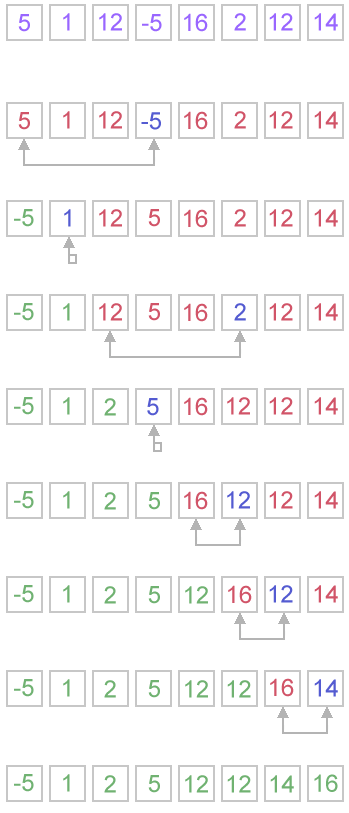| Sort | Average | Best | Worst | Space | Stability | Remarks |
| Bubble sort | O(n^2) | O(n^2) | O(n^2) | Constant | Stable | Always use a modified bubble sort |
| Modified Bubble sort | O(n^2) | O(n) | O(n^2) | Constant | Stable | Stops after reaching a sorted array |
| Selection Sort | O(n^2) | O(n^2) | O(n^2) | Constant | Stable | Even a perfectly sorted input requires scanning the entire array |
| Insertion Sort | O(n^2) | O(n) | O(n^2) | Constant | Stable | In the best case (already sorted), every insert requires constant time |
| Heap Sort | O(n*log(n)) | O(n*log(n)) | O(n*log(n)) | Constant | Instable | By using input array as storage for the heap, it is possible to achieve constant space |
| Merge Sort | O(n*log(n)) | O(n*log(n)) | O(n*log(n)) | Depends | Stable | On arrays, merge sort requires O(n) space; on linked lists, merge sort requires constant space |
| Quicksort | O(n*log(n)) | O(n*log(n)) | O(n^2) | Constant | Stable | Randomly picking a pivot value (or shuffling the array prior to sorting) can help avoid worst case scenarios such as a perfectly sorted array. |
this is bubble sort example

lets make it c language
#include <stdio.h>
#include <stdlib.h>
int main(int argc, char *argv[])
{
int arr[] = {5, 1, 12, -5, 16, 2, 12, 14};
int count;
int i=0, j=0, k=0, temp;
count = sizeof(arr)/sizeof(arr[0]);
for(j; j<count -1; j++){
for(i=0; i<count-1-j; i++){
if(arr[i]> arr[i+1]){
temp = arr[i];
arr[i]= arr[i+1];
arr[i+1]= temp;
}
}
k=0;
for(k=0; k<count; k++){
printf("%d ", arr[k]);
}
printf("\n");
}
return 0;
}
result :
1 5 -5 12 2 12 14 16
1 -5 5 2 12 12 14 16
-5 1 2 5 12 12 14 16
-5 1 2 5 12 12 14 16
-5 1 2 5 12 12 14 16
-5 1 2 5 12 12 14 16
-5 1 2 5 12 12 14 16
